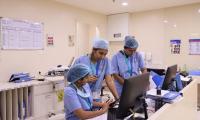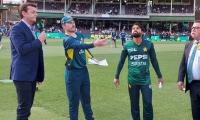In Sindh, students of class five are far behind in learning as compared to the students of the same group studying in other provinces of the country, says the Aser Pakistan in its latest annual report ‘Annual Status of Education Report 2019’.
According to Aser Pakistan, the report is a household-based survey conducted in 2019 across 155 rural and 20 urban districts of Pakistan assessing the learning outcomes of children aged between five and 16.
The summary report-card shows that 35 per cent of students in Balochistan can solve two-digit questions of mathematic, 48 per cent of students can read a story in their first language, and 40 per cent pupils can read a sentence in English. As compared to Balochistan, only 31 students in Sindh can solve tw0-digit questions of mathematic, 44 per cent of children can read a story in their first language and 27 per cent of schoolchildren can read a sentence in English.
Out-of-school children
In the section ‘Sindh Rural’, the report shows that less than 30 per cent of children aged between 3 and 5 attend preschool in Karachi, Sujawal, Sangar, Matiari, Dadu, and Shikarpur. However, more than 70 per cent of children aged between 3 and 5 attend preschool in Jamshoro, Shaheed Benazirabad, Nausheroferoz, and Jaccobabad. Also, Jaccobabad and Shaheed Benazirabad are the only districts where only three per cent of children aged between 6 and 16 are not attending schools, whereas Karachi West has the highest number of out-of-school children which is 30 per cent.
The states: “In 2019, 14 per cent of children were reported to be out-of-school which has remained the same as compared to the previous year which was also 14 per cent. Likewise, 10 per cent of children have never been enrolled in a school and four per cent have dropped out of school for various reasons”.
Arithmetic learning
Assessing learning levels of children, the report shows: that arithmetic learning levels in class five and class three have decreased as only 31 per cent of class 5 children could do two-digit division as compared to 32 per cent in 2018, while only eight per cent of children enrolled in class three could do two-digit division in 2019 as compared to 19 per cent in 2018. Alike, nine per cent of children in class three could read a story in Urdu or Sindhi as compared to 11 per cent in 2018.
The report notes: “Learning levels for grade five mapped to lower primary assessment tools of grade two level, have registered an improvement of 13 per cent to 17 per cent from 2014 to 2019, respectively … The challenges at sub-national levels deserve urgent attention”.
Private versus public schools
The report reads that children enrolled in private schools are performing better in English and Arithmetic compared to their government counterparts as 43 per cent of children enrolled in class five in a private school were able to read at least a story as compared to 44 per cent grade five children enrolled in government schools.
However, 35 per cent of private school children can read at least sentences in class five whereas only 26 per cent of government school children can do the same. In addition, 38 per cent of children enrolled in private and 30 per cent of children enrolled in government schools of class five were able to do division.
Measuring qualification, the report reveals that 46 per cent teachers of the surveyed government schools have completed graduation as compared to 44 per cent of teachers of private schools. Also, 48 per cent government schoolteachers had Bachelors in Education degrees as compared to 41 per cent of teachers of private schools.
Gender gap
The report shows that boys outperform girls in literacy and numeracy skills as 33 per cent boys and 25 per cent of girls could read at least sentences in Urdu or Sindhi, while 32 per cent of boys could read English words while 24 per cent of girls could do the same. Similarly, 28 per cent of boys were able to do at least subtraction whereas only 22 per cent of girls could do it.
Facilities in schools
The Aser 2019 indicates that 10 per cent of government high schools have computer labs while 45 per cent of private high schools provide computer labs facility to its students. Only 56 per cent state-run primary schools have toilets as compared to 95 per cent of private primary schools.
Clean drinking water is available in 60 per cent of government schools while 95 per cent of private schools provide the same facility to its students. Likewise, 51 per cent of the surveyed government primary schools had electricity connections and 35 per cent had playgrounds.
Reform situation
“In Pakistan, especially within the provinces of Punjab and Sindh, the Early Childhood Care Education [ECCE] has gained increased system-level attention and relevance in recent years. Sindh was the first province to develop a holistic ECCE policy in 2015, which focused on establishing developmentally appropriate preprimary ECCE that will support learning preparedness for primary schools to improve child outcomes in the province,” the Aser 2019 reads.
The report explains that the Sindh government has also developed its official provincial early childhood education (ECE) curriculum as well as initiated workforce reforms with a designate cadre for the subsector.
Enrolment in ECE
Sindh has registered improvement in enrolment figures as 37 per cent students enrolled in early childhood education classrooms in 2015 as compared to 44 per cent in 2018 and 2019. Khyber Pakhtunkhwa has shown a slight recovery in enrolment figures from 2018 when the figure drastically fell to a mere 30 per cent. On the other hand, the enrolment figures in Punjab, otherwise a pioneer in the ECE reform efforts, have shown remained static and hovering in the same range. Overall Punjab still leads all the other provinces in the percentage of children enrolled in the ECE, but there has been limited upwards progress.
An aerial view of the commercial district of Pakistan's port city of Karachi. — AFP/FileEchoes of TimeThe AAN Art...
Police officials are showing arrested alleged criminals and recovered seized weapons and drugs to media persons during...
Sindh Minister for Education and Mines & Minerals Development Syed Sardar Ali Shah speaks to someone at his office in...
Counter Terrorism Department officials stand guard in this undated image. — APP/FileThe Counter-Terrorism...
Karachi Mayor Barrister Murtaza Wahab speaks during a press conference in this still released on May 7, 2024. —...
A cordoned off area at the scene of a blast outside the Jinnah International Airport in Karachi on October 7, 2024....







